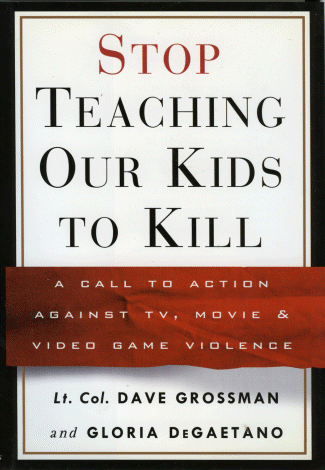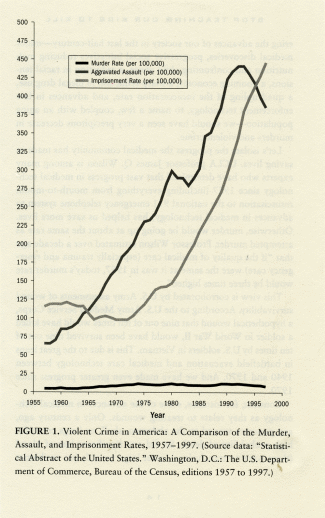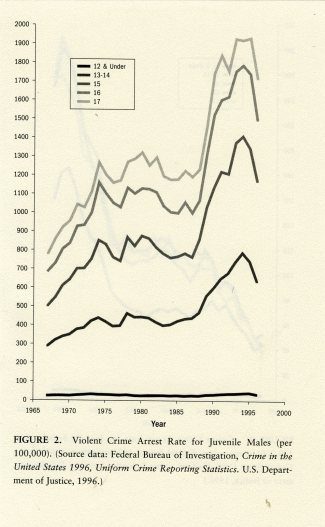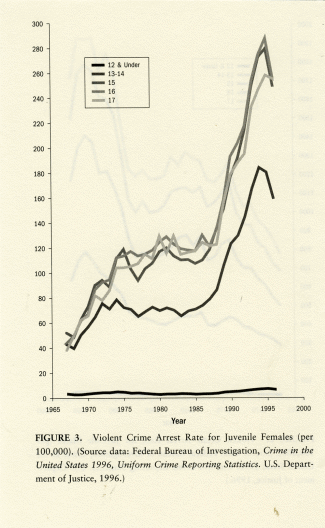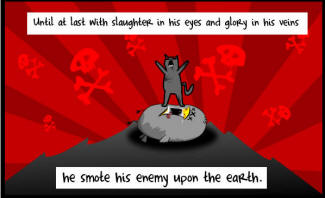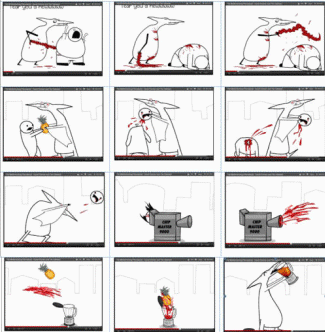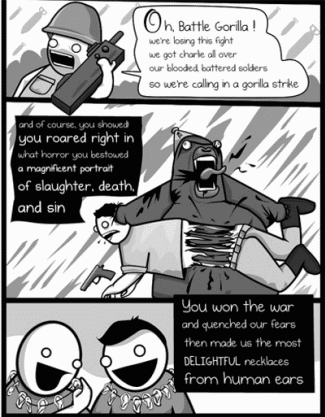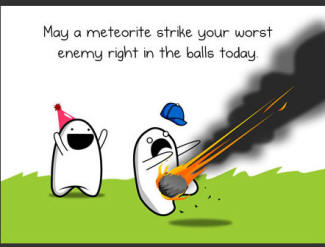2: NOT JUST A "TOASTER WITH PICTURES"Television did have an effect on me right from the beginning. In first grade, I was a member of a four-kid gang that went around imitating TV westerns. We'd disrupt class to play out scenes, picking up chairs and hitting people over the head with them -- except, unlike on TV, the chairs didn't break, the kids did. Finally, the teacher called my parents in and said, "Obviously he's being influenced by these shows, and if he's to continue in this class, you've got to agree not to let him watch television anymore." So from the first to second grade there was a dark period during which I didn't watch TV at all. And I calmed down and the gang broke up.
-- Brandon Tartikoff, former president of the National Broadcasting Company
THE DEBATE SHOULD be over by now. Scientific evidence overwhelmingly supports media violence as a major, significant factor contributing to real-life violence in our society -- and we'll prove it. It's a lot to absorb -- the findings of key studies in the last fifty years -- but it is of paramount importance that people understand just how much hard evidence exists on the subject. We'll also show you that the entertainment industry has patently ignored the majority of this evidence.
Since 1950 there has been a total of more than 3,500 research studies conducted in America on the effects of media violence on the population. One random analysis of almost 1,000 studies found that all save only 18 (12 of those were funded by the television industry) demonstrate there is a tangible correlation between violent entertainment and violent behavior. So why don't we just stop here and accept that? Would that it were that simple.
One of the problems with convincing people of this relationship is that the proof hasn't been made readily available to the public; many among us do not know the facts and often dismiss the idea out of hand. Also, it is hard, if not impossible, to irrefutably prove a pure correlation. That said, to put it into perspective, let us for a moment compare this issue to that of smoking and lung cancer.
There are many contributors to lung cancer besides smoking -- the polluted air we breathe, for example -- but we have isolated smoking, something we know for certain plays a role in lung cancer, and have made the tobacco industry pay a dear price for selling their product. Studies demonstrate a powerful, statistically significant correlation between media violence and the probability of violent behavior as an adolescent or adult. This kind of correlation data, demonstrating a relationship between two variables (screen violence and violence, or tobacco and cancer) was good enough, by itself, to result in successful legal action against the tobacco industry. But the case against tobacco has always lacked the kind of experimental data with humans that would demonstrate a clear-cut, scientific, cause-and-effect relationship. It is because of this that many scientists have been able to truthfully assert that, in the purest sense, the relationship between tobacco and cancer cannot be proven.
In the realm of cancer research, we cannot inflict cigarettes on every adult and child in one city, region, or nation, while completely denying it to a socially, ethnically, and demographically similar group. But in the realm of media research, the data from this kind of naturally occurring experiment can and has been conducted repeatedly, and always with powerful results demonstrating a clear cause-and-effect relationship between screen violence and violent behavior.
Similarly, it has never been possible to conduct true, controlled, laboratory experiments that expose an experimental group consisting of randomly selected children to cigarette smoke, while also maintaining a similar, randomly selected control group that is not exposed to cigarette smoke, and then demonstrate an immediate, short-term, statistically significant difference between the groups. But in the realm of media violence research scientists over five decades have been able to repeatedly demonstrate both short-term and long-term increases in violent behavior as a result of short-term and long-term exposure to manufactured horror.
We should be clear from the outset: the studies implicate media violence as a major influence; none indict it as the only cause of real-life aggression. Rather, what the studies demonstrate is that violent imagery as a form of amusement for children and youth -- who haven't fully developed their thinking functions, who need guidance to analyze and evaluate their experiences, and who have yet to develop accuracy in interpreting and describing feelings spurred by violent imagery -- is at very least a dangerous proposition. If adults, with their thinking functions developed, with their abilities to analyze and evaluate intact, and with their language skills proficient enough to express the feelings brought up by horrific images, can still be quite disturbed by violence on-screen, imagine how children and teens are affected and infected. Ours is a media culture careening out of control, with violence everywhere we turn. Understanding the links between real life and screen violence is paramount to taking effective, long-lasting action.
In the myriad studies done over the last four decades, experts have found three basic negative effects from exposure to screen violence: increased aggression, fear, and insensitivity to real-life and screen violence. Some studies highlight one or more of these effects, and other more inclusive, long-term experiments touch on all three.
INCREASING AGGRESSIONPerhaps the most direct effect that screen violence has on children is that it makes them more aggressive, both in behavior and in attitude. As mentioned previously, parents, teachers, and caregivers have noticed an increased intensity in child-on-child aggression. Words turn into pushing faster; pushing turns into punching; and punching turns into further acts of brutality more rapidly than seems natural, or at least than seemed natural a few decades ago. The studies repeatedly demonstrate that we see more physical violence by children and youth who watch screen violence and/or play violent video games. It's that simple. As the content of television becomes more violent, so do our children. Since 1982, television violence has increased 780 percent and in that same time period teachers have reported a nearly 800 percent increase of aggressive acts on the playground. Continual exposure, of course, has more long-lasting effects than short-term episodes.
The possibility that television increases levels of aggression and violence had been raised virtually since the advent of TV viewing in America. The first U.S. Congressional hearings on the question took place in 1952, when only around a quarter of American households had television sets and when what was on TV seemed, by our standards, fairly slow and boring. More often than violence, the "university of the air" brought parents and children programming designed specifically to inspire as well as entertain. Shows like Edward R. Murrow's See It Now invigorated adult minds, while children's shows with high educational value flourished. (This is not to say there isn't quality programming today -- there most certainly is. Unfortunately, it is being lost in a sea of mindless and violent fare.) By the mid-1950s, however, networks started panicking as they saw where all this quality programming was taking them. American families were turning off their TV sets and talking about what they had just watched. Or some nights they listened to the radio, because for intellectual stimulation it was still a viable medium, and TV's major competition. Neighbors visited each other. The TV was turned off, replaced by conversation and card games. Clearly the networks were not succeeding in gluing families to the tube.
Enter The Untouchables and Gunsmoke. These violent, action-packed shows immediately captivated adult viewers. Motivated by the urgent need to try something very different, networks stumbled upon the "violence formula." This formula assumes that the more graphic and gratuitous the violence, the more viewers will watch. It works fairly well until levels of violence in real life become comparable to what's on the screen. Then the novelty wears. And the violence levels need to be increased.
In the mid-1950s, as network executives introduced the violence formula, the U.S. Senate began a series of hearings on television violence held before the Senate Subcommittee on Juvenile Delinquency. These procedures began the model of expert testimony on TV violence in front of Congress that is still in place today. During the next few years many highly regarded experts testified that since the risk was so great and the payoff so small, television violence was a totally unacceptable risk. The ball was rolling.
III. CRIME AND VIOLENCE ON TELEVISION IN THE UNITED STATES
Results of certain studies of programs for children and programs aimed at adults but shown during children’s viewing hours
During the course of its investigation, the subcommittee deemed it appropriate to explore the content of television programs that might receive attention from young people of all ages. The staff surveyed the results of studies previously made with that thought in mind. The staff conducted some surveys of its own for comparison. The results were found to be substantially in agreement. It was found that a large amount of the time during children’s viewing hours is devoted to the subject matter of crime and violence. In several studies of program content, the hours from 5 to 7 p.m. on weekdays and from sign-on to 7 p.m. on Saturdays and Sundays are referred to as children’s hours. However, it has been recognized that many juveniles do not limit their television viewing to those hours; and there are many who view television after 7 o’clock in the evening through the week.
National Association of Educational Broadcasters
The National Association of Educational Broadcasters conducted four monitor studies of programs in New York City, New Haven, Los Angeles, and Chicago during the years 1951–53. One of the conclusions of the Chicago study is that—
the general picture is that of a relatively uniform program structure, which shows much less variation that one might expect from city to city or season to season.
The following may be cited as affording some indication of the large volume of acts of crime and violence presented in so-called drama for children.
Study of 85 percent of the total program time of the 7 television stations in New York for the week of January 4–10, 1953, and for a similar week in January 1952 revealed that the number of acts and threats of violence was manifold and had increased substantially between 1952 and 1953. In the 1953 study week a total of 3,421 acts and threats were observed—an increase of 15 percent over 1952. This meant an average of 5.8 acts and threats of violence per hour in 1952, of 6.2 acts and threats of violence per hour in 1953. These figures are, of course, cumulative for the seven stations and obviously no child could be individually exposed to all programs. It was also noted that during the week of January 4–10, 1953, children’s television hours in New York City were twice as saturated with violence as other hours. . . .
IV. INQUIRING FOR A CAUSAL RELATIONSHIP BETWEEN THE VIEWING OF CRIME AND VIOLENCE ON TELEVISION AND DELINQUENT BEHAVIOR
Concern expressed for cumulative effect of crime and horror
The cumulative effect of crime-and-horror television programs on the personality development of American children has become a source of mounting concern to parents. Several generalizations can be made concerning many of the programs shown during children’s viewing hours. It was found that life is cheap; death, suffering, sadism, and brutality are subjects of callous indifference and that judges, lawyers, and law-enforcement officers are too often dishonest, incompetent, and stupid. The manner and frequency with which crime through this medium is brought before the eyes and ears of American children indicates inadequate regard for psychological and social consequences. What the subcommittee tried to determine was: Are these presentations a contributing factor in juvenile delinquency?
The subcommittee is aware that no comprehensive, conclusive study has been made of the effects of television on children. On October 1, 1954, a 2-year study of the effects of television on adolescents and young people was initiated by the Nuffield Foundation, Nuffield Lodge, Regents Park, London, N.W. 1. Research teams are being selected of scientists, educators, statisticians, and psychologists. The British Broadcasting Corp. has expressed approval of the study and has also announced that its Audience Research Department is to study the effects of television on adults.
There is reason to believe that television crime programs are potentially much more injurious to children and young people than motion pictures, radio, or comic books. Attending a movie requires money and the physical effort of leaving the home, so an average child’s exposure to films in the theater tends to be limited to a few hours a week. Comic books demand strong imaginary projections. Also, they must be sought out and purchased. But television, available at a flick of a knob and combining visual and audible aspects into a “live” story, has a greater impact upon its child audience.
Views of representatives of the television industry
Several spokesmen for the television industry during the initial hearings testified to the effect that there is nothing wrong with television programs today and all children may view them without harmful effects.
During the hearings on television, Merle S. Jones, vice president in charge of Columbia Broadcasting System-owned stations and general services, cited Doctors Sheldon and Eleanor Glueck’s study, “Unraveling Juvenile Delinquency,” as revealing a major finding:
That the basic causes of delinquency behavior appear to be in faulty child-parent relationships during the first 6 or 8 years of the child’s life. * * * The authors of this monumental study find it unnecessary to discuss the role of mass media as a possible cause of juvenile delinquency.
It should be pointed out, however, that the Gluecks were not concerned with the mass media in their study of delinquency simply because this wasn’t within the focus of their study. When they appeared before the subcommittee in December 1953, Senator Hennings questioned them as to whether they had considered the effects of television directly in connection with their studies. Professor Glueck replied:
Not in the kind of detail * * * that one would like to. The question you raised * * * is a very fundamental one, because you are dealing there with influences that permeate our whole culture.
He went on to say—
* * * we may say that a consistent hammering away influence of an exciting or a salacious kind, day in and day out, day in and day out, must have an erosive effect on the mind of the youth * * *.
Professor Glueck did point out that these influences are always selective, which is in accord with the subcommittee’s belief that these presentations are sought out by those children who are least able to tolerate this kind of material. . . .
James L. Caddigan, director of programming and production, Du Mont Television Network, Allen B. Du Mont Laboratories, Inc., said:
The broadcaster’s responsibility toward children cannot be discharged by the scheduling of a special group of children’s programs. Every moment of every program telecast must be tailored to the highest standards of respect for the family and the home.
Statements of the above nature were prevalent during the hearings. However, the program content as monitored not only by the subcommittee staff but by other research groups reveals the fact that the chasm between what the television people feel is good programming and what is actually telecast is indeed a wide one.
Mrs. Grace M. Johnson, director of continuity acceptance, American Broadcasting Company Television Network said in referring to criticism of radio programs in 1942:
At that time management stated that if it could be proven that these programs were harmful to children, they would be eliminated.
Mrs. Johnson referred to the early movies she attended as a child:
Which included stereotypes of racial and religious groups, and the standard cliff-hanging scenes to be continued the next time. We attended these make-believe shows—excited and exhilarated to fever pitch and then we went home to a cold glass of milk or hot cup of cocoa, depending on the season. Were we to examine these pictures today and compare them with the present well-planned and executed TV programs we would find that the present fare is far superior to the past.
In regard to Mrs. Johnson’s first statement, the subcommittee believes that the proof that the programs are not harmful should be obtained before the programs are shown, not afterward. Parents would never feed their children food which contained possible harmful ingredients. The food must be tested before it is put on the market for public consumption. As to Mrs. Johnson’s second observation, the subcommittee would like to point out that many of the shows viewed by its staff actually were the same serials and westerns she referred to. What is different is the fact that this material is shown not once a week or once a day, but 22 to 28 hours (taking the total for several stations) per day, every day, creating an entertainment diet containing violence in volume unknown to any previous generation of children. . . .
Views of certain other observers as summarized in hearings
Conclusive research is lacking, but there are available opinions on the effects of crime and violence presentations upon children based on opportunities for observation by qualified persons. Such opinions are not in unanimous agreement. The opinions of those expressing fears regarding the effects of such presentations upon children might be summarized in the following terms: First, they point out that violence materials are anxiety and tension producing. The well-adjusted child may well be able to tolerate added tension that would be acquired through viewing television, but the emotionally crippled or damaged youngster may have very little tolerance for this added tension that has been introduced into his life through the television set in the front room. Although it is likely that no well-adjusted child will be badly warped by make-believe violence, on the other hand, it isn’t easy to tell which children are insecure or maladjusted.
The second possible detrimental effect, they point out, is that materials presented, scenes of crime and violence, may well teach techniques of crime. . . .
The third contention was that acts of crime and violence may provide both suggestions and a kind of support for the hostile child, leading him to imitate these acts in expression of his own aggression.
Fourth, it was also feared by some that repeated exposures to scenes of crime and violence may well blunt and callous human sensitivity to, and sympathy for, human suffering and distress—that is, what the effects may be, on a child seeing 5, 6 or 7 people killed each afternoon, in terms of making callous his normal sensitivity to that kind of human destruction, is an unknown quantity. . . .
APPENDIX . . .
CHILDREN OF TELEVISION—SOME OPINIONS
(Published by National Association for Better Radio and Television, Los Angeles, Calif.)
Television will have an effect on your lives even if you never own a TV set and never see or hear a broadcast. The fatal weakness of all efforts to control the excesses and correct the errors of television in the United States is the attitude of people who think themselves untouched because they themselves never look at inferior programs or never see television at all. But there is no immunity—there is no place to hide. So with the parents whose children are never permitted to watch the sadism and horror of the 150 murders which infest our television screens each week. They imagine themselves safe. But you cannot buy immunity by turning away from what you do not like. The fact is, the 1 child who does not see horror programs lives and will live in the world created by the 50 who do. GILBERT SELDES
Bennett L. Williams, former newspaper reporter (police beat): The crime programs on radio-TV, and the so-called comic strips in our newspapers are creating crime and criminals every day. The police are doing a good job, and then some; but such programs are promoting crime faster than we can increase our police force.
The radio-TV crime programs hold the police up to public ridicule. The police are depicted as a bunch of stumble bums. Naturally our children grow into a contemptuous regard for the police. Those radio and TV poisoned children get the notion that they too are above the law, just like the “private eyes” are, and that they too can shove policemen around. . . .
Walter Lippmann (Los Angeles Times) (The Rise of Teenage Crime): There can be no real doubt, it seems to me, that the movies and television and the comic books are purveying violence and lust to a vicious and intolerable degree.
There can be no real doubt that public exhibitions of sadism tend to excite sadistic desires and to teach the audience how to gratify sadistic desires. Nor can there be any real doubt that there is a close connection between the suddenness of the increase in sadistic crimes and the new vogue of sadism among the mass media of entertainment.
Censorship is no doubt a clumsy and usually a stupid and self-defeating remedy for such evils. But a continual exposure of a generation to the commercial exploitation of the enjoyment of violence and cruelty is one way to corrode the foundations of a civilized society.
For my part, believing as I do in freedom of speech and thought, I see no objection in principle to censorship of the mass entertainment of the young.
Until some more refined way is worked out of controlling this evil thing, the risks to our liberties are, I believe, decidedly less than the risks of unmanageable violence.
-- Senate Committee on the Judiciary, Subcommittee to Investigate Juvenile Delinquency, Television and Juvenile Delinquency, interim report, 1955, Committee Print.
In 1969, Senator John Pastore from Rhode Island, chair of the Senate Subcommittee on Communications, held a hearing to which he invited the usual group of parents, teachers, social scientists, and network executives. He also invited the surgeon general of the United States, something that had never been done before. The surgeon general had just concluded the first report on smoking and health, which caused quite a stir because it indicated a link between smoking and lung cancer. When the surgeon general subsequently commented on TV violence, he put the issue in the same context as the smoking controversy -- as a public health issue. This said a lot.
Much of the American public is unaware that many experts have thought of media violence in this context since the late 1960s. The stonewalling of information about the negative effects of media violence has been so great that even today, many physicians, psychologists, and media literacy advocates are under the impression that referring to media violence as a public health concern is a new way to frame the issue. If nothing else, it demonstrates how buried these vital reports have been over the years.
The surgeon general's report,
"Television and Growing Up: The Impact of Televised Violence," was released in 1972 and stated that there was strong evidence that TV violence can be harmful to young viewers. Confirming the continually accumulating body of research, this three-year study consisting of sixty new research projects further documented that exposure to screen violence increases the likelihood of aggression.
By 1978, the evidence was piling up. TV violence was making kids meaner and more aggressive. Yet, during this same period, television networks were simply unwilling to keep a consistent stream of nonviolent programming available to the public. They refused to acknowledge the validity of the compelling body of research consisting of hundreds of studies. They would not budge. As network executives manufactured more and more horror for increased profits, they continued to ignore an unquestionable fact: it was our children who were paying the price. And, of course, they knew that. Across the decades the results of studies demonstrating aggression in children and teens after viewing violence on TV or in a movie have held true, whether through measures such as self-reports or through teachers' observations. And they continue to hold true for more recent studies in which the measures of aggressiveness have become more sophisticated.
In 1982, the National Institute of Mental Health issued a pivotal report. This was a review of over 2,500 studies on the effects of TV violence -- about fourteen volumes of documentation. The conclusion indicated a consensus among members of the research community that " ... in magnitude, television violence is as strongly correlated with aggressive behavior as any other behavioral variable that has been measured."
The year 1984 brought the findings of a very significant twenty-two-year longitudinal study by Professors Leonard Eron and L. Rowell Huesmann. These pioneering researchers followed the fates of 875 children living in a semi-rural U.S. county. Taking into account their baseline aggressiveness, intelligence, and socioeconomic conditions, it was found that, for both boys and girls, the amount of television they were watching at age eight predicted the seriousness of criminal acts for which they were convicted by age thirty. This was a big, and frightening, leap to make. It pushed the evidence one major step forward.
Perhaps scariest of all is the fact that Eron and Huesmann further observed second-generation effects: Girls and boys watching more television at age eight were later, as mothers and fathers, punishing their own children more severely than those parents who had watched less television as children. Remarkably, how much television violence a thirty-year-old parent had been watching at age eight predicted their children's degree of physical aggressiveness even better than it predicted their own at age thirty! It is something to consider that these second- and now third-generation effects are accumulating and rippling down through the generations during today's era of unprecedented youth violence.
The mid-1980s brought another seminal study, this time by Tannis McBeth Williams. Her 1986 conclusions were reminiscent of what you have just read about on the screen violence/aggression equation; but what is fascinating is how she conducted her experiment. She and her associates at the University of British Columbia investigated the effect of the introduction of television upon the children in a remote, rural community, called Notel, for "No Television. "
Researchers studied both children and adults before television was introduced into Notel and two years after its introduction, and compared these results to those from two other communities that had television. The children and adults in Notel showed a significant increase in physical and verbal aggression after the two years. Also, children as well as adults more often used aggressive behavior as a successful and acceptable method for achieving goals.
With the introduction of television, young children's behavior changed more significantly than that of older children or adults. Forty-five first and second graders in the three towns were observed during free play for rates of objectively measured noxious physical aggression -- such as hitting, shoving, and biting -- before television was introduced into Notel. The same forty-five children were then observed again during free play two years later. To prevent bias in the data, the research assistants collecting the data were actually kept uninformed as to why they were observing children in these three towns for rates of hitting, shoving, and like behavior. Furthermore, an entirely new set of research assistants was employed the second time around, so that a data gatherer would not be influenced by some recollection of the child's behavior two years earlier.
As would be expected, rates of noxious physical aggression did not change in the two control communities, since they had already been exposed to television to begin with. In contrast, by two years after the introduction of television, rates of physical aggression among Notel's young children had increased by 160 percent! The increase was observed in both boys and girls, in those who were aggressive to begin with and in those who were not.
Even though social scientists had been studying the relationship between television and aggression for several decades, what is perhaps the most telling indictment did not come from social scientists, and it did not start as a study of television. By 1981, the rate of real-life violence had risen to the level where it was finally being identified as a public health issue. Dr. Brandon Centerwall, M.D., an epidemiologist, was asked to help start the violence research program at the National Centers for Disease Control in Atlanta, Georgia. A central issue confronting the research team was the doubling of the murder rate in the United States since the 1950s. That the rate had doubled was indisputable. The question was, why?
Dr. Centerwall approached this as a question of epidemiology, searching through rigorous statistical analysis for the causes of the "epidemic of violence." He considered every possibility that any research evidence had ever suggested might reasonably be a cause, including changes in urbanization and economic conditions; the effect of the post-World War II baby boom; trends in alcohol abuse, capital punishment, and civil unrest; changes in the availability of firearms; and television. Television was included as part of the array. It was not considered more likely to provide an explanation than any of the other proposed candidates.
Over seven years of research, first at the Centers for Disease Control and later at the University of Washington, Dr. Centerwall gathered statistical data and tested the various factors to see if a causal relationship with the rising level of violence could be identified. One by one, as the research evolved, factors were eliminated for significant causal relationships. Yet each time the television hypothesis was subjected to the testing, it quite stubbornly refused to be eliminated. As each of the other candidates dropped away, television slowly moved to front and center.
After testing rigorously for confounding cross-relationships with other possible causes, the conclusion was inescapable. And the process of arriving at the epidemiological conclusion was so gradual that, in Dr. Centerwall's words, "There never was a moment of 'Aha!' It simply happened."
After painstaking testing all over the world, Dr. Centerwall blew the roof off the subject by stating that if "television technology had never been developed, there would today be 10,000 fewer murders each year in the United States, 70,000 fewer rapes, and 700,000 fewer injurious assaults."
As mentioned, there have been thousands of like studies that have come up with similar conclusions.
Centerwall's study sticks out for his method -- and for the jaw-dropping nature of his indictment of television violence. The results of this study were published in a "special bulletin" in the Journal of the American Medical Association in 1992. If the study had told us that 10,000 people per year were dying from an infectious disease, it would have made the evening headline news. Alas, almost nobody in this country has heard of Dr. Centerwall or his findings.
DESENSITIZING USAnother effect of screen violence on children -- and, for that matter, adults -- is that they become more desensitized to violence and less outraged by its effects.
Callousness toward brutality sets in and a "so what?" attitude begins to frame the context by which horrific acts are seen. Consequently, more justification for violence takes place in the minds of these individuals. Images of violence as "cool" serve to reinforce deviant attitudes and result in less empathy, compassion, and understanding for human suffering.Violence does not occur solely via an attacker's aggressiveness. Violence is also caused by the unwillingness of others to intercede. To update Edmund Burke, it is sufficient for violence to flourish that bystanders do nothing. In a classic 1974 study, fifth-grade children were randomly assigned to watch either fifteen minutes of a television crime drama -- including several shootings and other violent acts -- or fifteen minutes of a televised baseball game. Afterward, the investigator left each child in charge of supervising the behavior of two younger children by means of a television monitor. "I imagine they'll be okay," they were told. "But sometimes little kids can get into trouble, and that's why an older person should be watching them. If anything does happen, come get me."
After the investigator left, the television monitor showed the two younger children getting into a quarrel, which then escalated into threats and physical blows; finally, the camera was knocked over and, amid shouts and crashing, the monitor went dead. (Unbeknownst to the older children, the fight was taped, not live, so all children witnessed exactly the same sequence.) As compared to the children who had watched the baseball game, the children who had just finished watching fifteen minutes of television violence were five times more likely to simply fail to summon help.
Cultural insensitivity is also demonstrated by our increased ability to tolerate more and more graphic displays of violence in the media. Hyperviolent movies such as Natural Born Killers, Pulp Fiction, or The Matrix would not have been tolerated, let alone achieved commercial success, in 1939 -- the year that Wuthering Heights, The Wizard of Oz, and Gone With the Wind were released. PG-rated Dick Tracy, one of the more benign movies of the 1990s, with only fourteen slayings, had a higher body count than the original 1974 Death Wish, which by many people's standards was a really violent film. The definition of what is socially acceptable, even normal, alters according to our level of desensitization. "Simple" violence becomes passe; seeing a few dead bodies makes little or no impression on us. Body counts rise, violence is more graphic, real. And we soon start feeling comfortable with the kind of ultra violence now seen regularly on television and at the movies. Another way we become desensitized to such violence is when it's presented without some kind of redeeming message. In 1990, social critic Mark Crispin Miller said this: "In Bullitt (1968) and The French Connection (1971), in The Searchers (1956), and in movies of Sam Peckinpah, the violence, however graphic, was muted by a deep ambivalence that shadowed even the most righteous-seeming acts of vengeance, and that therefore suppressed the viewer's urge to join in kicking. In contrast, screen violence now is used primarily to invite the viewer to enjoy the feel of killing, beating, mutilating." The point being, viewing violence for its own sake is a destructive trend. Our children get nothing out of it except the message that violence is okay, even fun.
We can also measure our cultural insensitivity by what we deem appropriate viewing for children. For instance, the Power Rangers show, popular with toddlers and preschoolers, contains about two hundred acts of violence per hour. It's interesting to note that the adolescents who are now committing horrendous crimes in Jonesboro, Paducah, and Littleton, were weaned on G.I. Joe and She-Ra -- cartoons averaging twenty-five acts of violence per hour. In contrast, adult shows contain far fewer acts of violence per hour.
Perhaps our cultural desensitivity about age-appropriate fare can be best understood in comparison to other countries. It was common for American preschoolers to see the Batman movies or, especially, the Teenage Mutant Ninja Turtle movies, during the 1990s. Most parents didn't think twice about it. However, it's interesting to note that British children under the age of twelve were not allowed to see Batman, and Swedish children under the age of fifteen could not get in to see the first two Turtles movies.
This increase in the level of violence on-screen, and the accompanying increase in desensitivity that it inflicts on children especially, means that the entertainment industry must up the ante (twenty-five acts of violence per hour to two hundred!) to hold and, certainly, to increase viewership. The more often our children are exposed to violent programming, the more it is seen as normal and natural -- and the less attention-grabbing it becomes. If screen violence seems like an addictive drug, you're on the right track. The more one takes in, the stronger the next dose must be in order to attain the same level of response. The fact that all forms of media violence, whether on TV or in film and video games, have become more and more graphically brutal and sensational attests to the effectiveness of desensitization.
INCREASING FEARThe third symptom of violence as entertainment is increased fear in our society. A constant diet of violent portrayals can make people more distrusting and exaggerate the threats of violence that really do exist. Nightmares and long episodes of anxious behavior are common for young children exposed to violence on TV or in a film.
Violent and/or scary TV programs and movies have both immediate and long-term effects on children. Immediate reactions include intense fear, crying, clinging behaviors, and stomachaches. Long-term reactions vary from nightmares and difficulty sleeping, concern about being hurt or killed, and aversion to common animals. In her book, Mommy, I'm Scared: How TV and Movies Frighten Children and What We Can Do to Protect Them, Joanne Cantor, Ph.D., asks: "How much fright can a child take? When does the spine tingling cease to be fun? ... There have been several case studies in medical journals telling about young people who had to be hospitalized for several days or weeks after watching horror movies such as The Exorcist and Invasion of the Body Snatchers. One recent article reported that two children had suffered from post-traumatic stress disorder, a diagnosis usually reserved for Vietnam War veterans and victims of physical violence, as a result of watching a horror movie on television. One of the children described in the article was hospitalized for eight weeks."
By watching violence, both children and adults can come to see the world as a much more dangerous place than it really is, and act upon those misperceptions. Research on trauma suggests that all it takes is one terrifying experience, especially for children, to form a lifelong memory, one that it is difficult to erase. Some 23 million Americans suffer from some sort of anxiety-based disorder. Is exaggerated, irrational fear some part of the modern condition? Stephen Hall, in an article in the New York Times Magazine, points out: "It may be one of the paradoxes of our age that we've created entire economies around activating this fear system under safe conditions in the form of theme-park rides and Stephen King novels and films that have us on the edge of our seats."
Most of us protect our children from the violence that exists on the street, mainly because we don't want them to be physical victims of it, but also because we are painfully aware of how exposure to it will skew their world perception. So what sense does it make for us to allow them to be saturated with images that frighten and terrorize?
George Gerbner, a distinguished researcher currently at Temple University, has been studying the content of TV violence in prime time, and in children's cartoons, and the effects of that content on both children and adults, for over twenty years. In 1990, he and Nancy Signorielli released a significant body of work that showed that a steady diet of violent programming caused both children and adults to see the world and other people as more dangerous than they actually are. He called this effect "the mean world syndrome."
Gerbner and his associates have tracked public perceptions of society in relation to the respondents' extent of television viewing. Those who watch five or more hours of television daily are more fearful than those who watch three hours or less. Heavy viewers are more apt to overestimate the chance that they will be victims of crime (greater than FBI crime reports for their locale would suggest). These people have also taken more precautions than others, such as limiting their travel at night and changing the security in their homes. They look out for themselves more, trust others less, and see the world quite differently than do those who do not perceive the possibility of violence at every turn.
The research demonstrated that TV violence distorts a person's concept of reality, changing his or her attitudes and values. Thus, TV creates a perceived need for guns, which in turn creates violence, which reinforces the "need" for guns, and so on, in an endless, tragic spiral.
As our children were becoming more aggressive, desensitized, and fearful, TV violence continued to escalate. A [August] 1994 study by the Center for Media and Public Affairs identified 1,846 violent scenes on network and cable programs between 6 A.M. and midnight on one day in Washington, D.C. Most of these were of an extremely horrific nature, and without context or judgment about social acceptability. The most violent periods were between 6 and 9 A.M., with 497 violent scenes, or 165.7 per hour, and between 2 and 5 P.M., with 609 violent scenes, or 203 per hour. These are the times of day when children and youth are most likely to be watching. This is no coincidence. The study also concluded that from 1992 to 1994 depictions of serious violence increased 67 percent, violence in promos and trailers almost doubled, and violence in network and local news programs increased 244 percent.
We must remember that this fallout in the early 1990s was the result of years of "all talk and no show" on the part of the networks. Remember Newton Minow's "vast wasteland" speech of 1961? Minow, then the newly appointed chairman of the FCC, sat down and watched one full week of television in preparation for his inaugural address to the National Association of Broadcasters (NAB). Minow's advice to the broadcasters of the 1960s could be addressed to them today (except that today our "stations" never go off the air!):
I invite you to sit down in front of your television set when your station goes on the air and stay there ... until the station signs off. I can assure you that you will observe a vast wasteland. You will see a procession of game shows, violence, audience participation shows, formula comedies about totally unbelievable families, blood and thunder, mayhem, violence, sadism, murder, western bad men, western good men, private eyes, gangsters, more violence and cartoons.
Although broadcasters responded to Minow's speech by agreeing to assign large parts of the UHF spectrum to public broadcasting, they did not take violent programming off the air, nor reduce violent content. The "vast wasteland" remained a metaphor for television content throughout the 1970s.
In 1981, the newly appointed chair of the FCC, Mark Fowler, prepared for his inaugural address to the NAB in the same way Minow had -- by watching a week of television. However, Fowler came to the opposite conclusion. Instead of a vast wasteland, he saw a "vast richness," despite the fact that TV violence had increased significantly since 1961.
Fowler said that television was just another appliance, "a toaster with pictures," and that we need not be concerned. Yet, in the 1980-81 season, when the FCC was discussing deregulation of children's programming, violence on children's television shows reached its highest level in twenty years: thirty-three acts of violence per hour. The deregulation came in 1984, and with it more reason for concern. Now, for the first time, toy manufacturers could develop thirty-minute cartoon "commercials" for their products. The sponsors, companies from the toy industry, basically began to overrun the television industry. By 1987, the sales of violent toys had soared more than 600 percent. Cartoons, more violent than ever, flooded the market, along with their icon toy counterparts with which youngsters could practice violent play while they weren't watching. Action figures based on popular cartoon characters acted as enablers to our children's TV violence addiction.
Then all the commotion began. Congressional hearings in the late 1980s resulted in the Television Violence Act (TVA) of 1990. This legislation provided the television industry with temporary antitrust immunity so that they could work together to develop "voluntary guidelines" on television violence.
Also in 1990, the Senate and the House passed the Children's Television Act, but President Bush refused to sign it, saying it bordered on infringement of the First Amendment. He did, however, allow it to become law. The Children's Television Act made two provisions:
1. Commercials during children's programs could not exceed 10.5 minutes per hour on weekends and 12 minutes per hour on weekdays.
2. Television broadcast licenses could not be renewed unless the station had complied with the first provision and had served the "educational and information needs of children" by providing at least three hours a week of educational programming.
In the coming years, many experts and parents would decry the lists of programs that networks identified as "educational." The networks deemed such programs as G.I. Joe, Leave It to Beaver, The Jetsons, and James Bond, Jr. as examples of shows that served the educational and informational needs of children.
Clearly the industry regarded the Television Violence Act and the Children's Television Act as a joke. And we found that, tragically, the joke was on us. The 1990 report, "Watching America," which had reviewed six hundred prime-time television shows, analyzed TV's portrayal of the society it is supposed to serve. Its conclusions were certainly not a laughing matter:
Our studies show that an evening of prime time puts to shame a night at the [police] station house. Violent crime is far more pervasive on television than in real life, and the disparity widens as the danger increases. For the most serious crime of all, the difference is most dramatic. Since 1955, television characters have been murdered at a rate of 1,000 times higher than real-world victims.
Yet, two years later the networks were still in mass denial. The words of Barry Diller, at the time chairman of Fox, Inc., typify the extent of this denial: "The issue [of TV violence and its effects] is so complex, it's not appropriate to deal with this in some superficial way.... I don't think we know enough yet." How much more could he possibly want to know?
By 1992, the industry, having been forced to do so by the TVA, had established a set of guidelines. Within this venue, at this time, before this audience, they simply could not deny the many negative effects of TV violence any longer, and thus found themselves to be morally and legally obligated to construct what they called a "Statement of Principles." Note that, while Congress had demanded the establishment of a set of "guidelines," what the industry created were "principles." Being forced to establish guidelines (or principles) by no means forces the industry to follow them. Consider some of the following text and compare it to what you see on your television today. If you see a wide disparity, you're not alone.
• Children's programs should attempt to contribute to the sound, balanced development of children and to help them achieve a sense of the world at large;
• Violence, physical or psychological, should be portrayed only in a responsible manner and should not be used exploitatively. Where consistent with the creative intent, programs involving violence should present the consequences of violence to its victims and perpetrators;
• Presentation of the details of violence should avoid the excessive, the gratuitous, and the instructional;
• The use of violence for its own sake and the detailed dwelling upon brutality or physical agony, by sight or by sound, should be avoided;
• Particular care should be exercised where children are involved in the depiction of violent behavior.
The fact that the television industry came up with such principles strongly suggests they knew what they should be doing -- what was right. But it doesn't take much research at this point to figure out that they ignored their own advice. And sure enough, more pressure from Congress and the threat of restrictive legislation prompted the cable industry to sponsor the three-year (1996-1998) National Television Violence Study (NTVS) at a cost of $3.5 million. (The broadcast industry, not to be outdone, also financed its own three-year study during this time period at a cost of $1.3 million.)
The National Cable Television Association (NCTA) awarded a three-year contract to Mediascope, Inc., to administer the largest study of television content ever undertaken. Mediascope, in association with the Universities of California, North Carolina, and Texas, was selected to conduct the research after a competitive process that attracted proposals from many leading experts in media research.
In February 1996, the first-year analysis was released. It is important to note that this study was the most comprehensive evaluation of its kind. Unlike past studies, this project did not merely count the number of violent acts and report them. Rather, the researchers developed nine contextual features to measure the harmful effects of that violence. For instance, they determined that
television violence poses the greatest risk if there are repeated acts using a conventional weapon, if violence is put into a humorous context, or if it is morally justified in some way.The conclusion of the first year of the study was that "psychologically harmful" violence is pervasive on broadcast and cable TV programs. The NTVS found not only that 57 percent of programs contained some violence, but also that the context in which this violence occurs can have harmful effects.
In 1997, the second-year summary of the research was released, with similar results. And in April 1998, third-year results told the same story and made a mockery of the networks' "principles" and the so-called cooperation on the topic of reducing TV violence. Facts such as these emerged:
• Nearly 40 percent of the violent incidents on television are initiated by characters who possess qualities that make them attractive role models.
• One-third of violent programs feature "bad" characters who are never punished.
• More than half of the violent incidents feature physical aggression that would be lethal or incapacitating if it were to occur in real life.
• At least 40 percent of the violent scenes on television include humor.
• 60 percent (up 3 percent from the 1996 results) of television programs contain violence and more than 60 percent of the violent incidents involve repeated behavioral acts of aggression.
• Youngsters who watch two hours of cartoons each day are exposed to five hundred high-risk portrayals of violence per year that teach aggressive behaviors.
• TV ratings tend to attract many children to very violent, inappropriate programs by alerting kids to their existence.
Marty Franks, senior vice president of CBS, strongly disputed the study. He said his network's prime-time lineup featured programs with little violence. Franks claimed: "This study persists in using the same flawed methodology that led several years ago to the twenty-fifth anniversary of Laugh-In being named that year's most violent program by simply counting acts of violence without taking dramatic context into account."
False.
As stated above, the National Television Violence Study was the most comprehensive television violence study ever, incorporating extensive contextual features. The bottom line is that the networks have reverted to gross misrepresentations of the vast body of research in this area.
In response to the National Television Violence Study, the American television industry simply rewrote their own history by perpetuating a quarter-century of smoke screens and denials. In fact, television violence continued to escalate both on cable and noncable networks over the three-year period of the study. What the industry did to try to divert attention from the core of the problem was to inaugurate both the rating system and the V-chip (a device that parents can use at home to block violent programming).
Writing about the fallout from the industry-supported research, Dr. George Comstock, Newhouse Professor at the S. I. Newhouse School of Public Communication at Syracuse University, pointed out: "What had begun as a concern over the harmfulness of violent portrayals, and especially in regard to the facilitation of antisocial behavior on the part of viewers, became an endeavor simply to inform parents so that they could better govern their children's viewing .... The social and behavioral sciences have empirically identified a problem and offered a solution (however difficult): the reduction of harmful portrayals. If the problem is those ... harmful effects, then labeling content for the V-chip exorcism will succeed only if all households comply. And if they were to do so, then there would be no need for the V-chip because the incentives to produce such content would be absent. The industry has substituted appearance for substance."
While U.S. network executives and film producers continued with wide-eyed innocence to plead ignorance of the vast amount of evidence, the rest of the world was penning their indictment for the perpetuation of the new "global aggressive culture" that was being marketed to children.
In 1998, the seminal work "Children and Media Violence: A Yearbook from the International Clearinghouse on Children and Violence on the Screen" was released by UNESCO. This is a four-hundred-page book describing worldwide studies of media violence, including the largest study ever conducted, which surveyed five thousand twelve-year-olds in twenty-three countries, and it thoroughly and irrevocably supported what studies for the last four decades have been literally screaming at the world and the entertainment industry. How much clearer can it possibly get?
We may have as a society been fascinated by violent imagery over the decades. But things are changing -- at least for adults. After five decades of escalating media violence, the public is showing signs of having had enough. A recent study examining 2,380 major movie releases from 1988 to 1997 indicates that the film industry produced 17.4 times more R-rated than G-rated films, yet G-rated films produced 8.35 times more profits per film than R-rated movies. PG-rated movies were second in profits, followed by R-rated, then NC-17 movies.
If the film industry is profit-driven, what drives the making of the R-rated violent films? If the TV industry has spent millions of dollars on their own studies demonstrating the validity of the scientific research, why do they continue to increase violence levels? Why is it that the broadcast industry is not following the very guidelines they themselves established? How can there even be any more argument when everyone in the industry agrees that thirty-second television commercials change adult behavior? If rapidly moving images and inane jingles flashed on a small two-dimensional screen can get adults to do things, why would violent images watched for hours on screens large and small have no impact on the behaviors of children and teens?
Along with the science has come the advice from the experts in child development. Yet the industry has refused to listen both to the evidence and to the purveyors of that evidence. Pediatricians, psychologists, educators, and experts on youth violence have taken on the enormous responsibility of making the industry pay attention and make significant changes. The responsibility should be reversed. It is not up to the child-care experts to get the industry to listen. They have no leverage to do that. We need to realize that when it comes to our children's viewing habits, the real media critics are not Roger Ebert and other journalists but rather the AMA, the APA, and the American Academy of Pediatrics. If the TV and movie industries truly had the interest of America's children in mind, they would actively engage the broad, mainstream consensus -- not just hire a few "experts" who basically agree with them. The entertainment industry has taken the approach of "How much poison can we put in the food and get away with it?"
As a result of all this undeniable research, many experts and organizations with moral and social responsibility for children's welfare have issued strong statements over the years. When organizations representing all of America's doctors, all of her psychiatrists, and millions of parents, call upon an industry to change (i.e., reduce violence on the public airwaves), and then that industry does exactly the opposite (i.e., increases the violence), this can be viewed as nothing short of complete and total contempt for the people of the United States.
The evidence is in. The debate is over. And we can no longer wait for the TV executives and movie moguls to change. As you will see in the next two chapters, the stakes are too high, way too high, for that.
